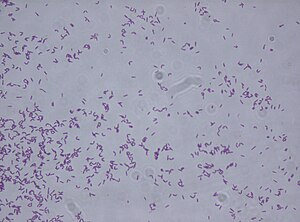Rhodococcus fascians
| Rhodococcus fascians | ||||||||||||
|---|---|---|---|---|---|---|---|---|---|---|---|---|

Rhodococcus fascians |
||||||||||||
| Systematics | ||||||||||||
|
||||||||||||
| Scientific name | ||||||||||||
| Rhodococcus fascians | ||||||||||||
| ( Tilford 1936) Goodfellow 1984 |
Rhodococcus fascians (referred to as Corynebacterium fascians until 1984) is a gram-positive bacterium thatcauses plant gall . Rhodococcus fascians is the only plant pathogenic bacterium of the genus Rhodococcus , its host range includes both a - and Dicotyledonous Plants a. It usually remains epiphytic , but can also form endophytic populations. The plant galls thatit produces by releasing cytokinins create an optimal living environment for the bacteria.
Physiology and morphology
Rhodococcus fascians is an aerobic, immobile bacterium belonging to the order Actinomycetales that does not form spores. Colonies on an agar plate appear orange in color and can have a smooth or rough surface. The cells can have different shapes and form branched hyphae as well as cocci or rod-shaped.
Systematics
Due to its GC content , the structure of the cell wall , the 5S and 16S rRNA sequences and the presence of tuberculostearic acid and mycolic acid , Rhodococcus fascians is one of the mycolic acid-containing genera among the Actinomycetales.
virulence
Rodococcus fascians infects both naked and covered suns . Affected plants develop typical symptoms such as leaf deformation, witch's broom and leaf galls , depending on their age and bacterial strain . The leaf deformations are caused by a widening of the parenchyma and growth of the vascular bundles, whereby the leaf surface is curved. All symptoms that are caused by Rodococcus fascians are not based on a transformation of the cells, but the bacteria usually remain outside the cells and release the substances, which then diffuse into the surrounding cells. However, bacteria were also observed in the intercellular spaces and in the cell wall itself.
Genes involved in virulence control
The virulence of Rhodococcus fascians is mediated by the genes on a plasmid . Strains lacking this plasmid are not infectious.
Research history
In 1927, Brown described fascinations in the root necks of Lathyrus odoratus , the scented flat pea , and she suggested that they were root neck gall tumors caused by a weak or special form of Agrobacterium tumefaciens . Ten years later, Tilford was able to show that it was not Agrobacterium tumefaciens but another bacterium called Phytomonoas fascians that was responsible. In 1942 the unclear taxonomy was partially clarified, the plant pathogen was classified as belonging to the Actinomycetes and renamed to Corynebacterium fascians, a name that lasted until 1984. Only then could it be classified as Rhodococcus , another genus within the Actinomycetes, based on chemical, genetic and phenotypic characteristics . It was later clarified that the resulting structures are not root neck gall tumors, but rather leaf galls that arise from the increased growth of shoot meristems.
Synonyms
The bacterium was previously known as Rhodococcus fascians and Rhodococcus luteus ( ex Söhngen 1913) Nesterenko et al. 1982 ). Since 1994 the two species have been grouped together under Rhodococcus fascians .
proof
- K. Goethals, D. Vereecke, M. Jaziri, M. Van Montagu, M. Holster: Leafy gall formation by Rhodococcus fascians. In: Annual Review of Phytopathology. 39, 2001, pp. 27-52, doi : 10.1146 / annurev.phyto.39.1.27 .
Individual evidence
Most of the information in this article has been taken from the sources given under references; the following sources are also cited:
- ↑ D.Vereeke, K. Cornelis, W.Temmerman, M. Jaziri, M. Van Montagu, M. Holsters, K. Goenthals Chromosomal locus that affects pathogenicity of Rhodococcus fascians. Journal of Bacteriology, Feb, 2002, 184 (4): 1112–1120, PMC 134788 (free full text)
- ↑ KLATTE (S.), JAHNKE (KD), KROPPENSTEDT (RM), RAINEY (F.) and STACKEBRANDT (E.): Rhodococcus luteus is a later subjective synonym of Rhodococcus fascians. Int. J. Syst. Bacteriol., 1994, 44, 627-630